
Rediscovering Japan

Rediscovering Japan
Travel (Nara Part 4 (Shoso-in/Saidaiji Temple/Kashihara Jingu)

by tomizuta
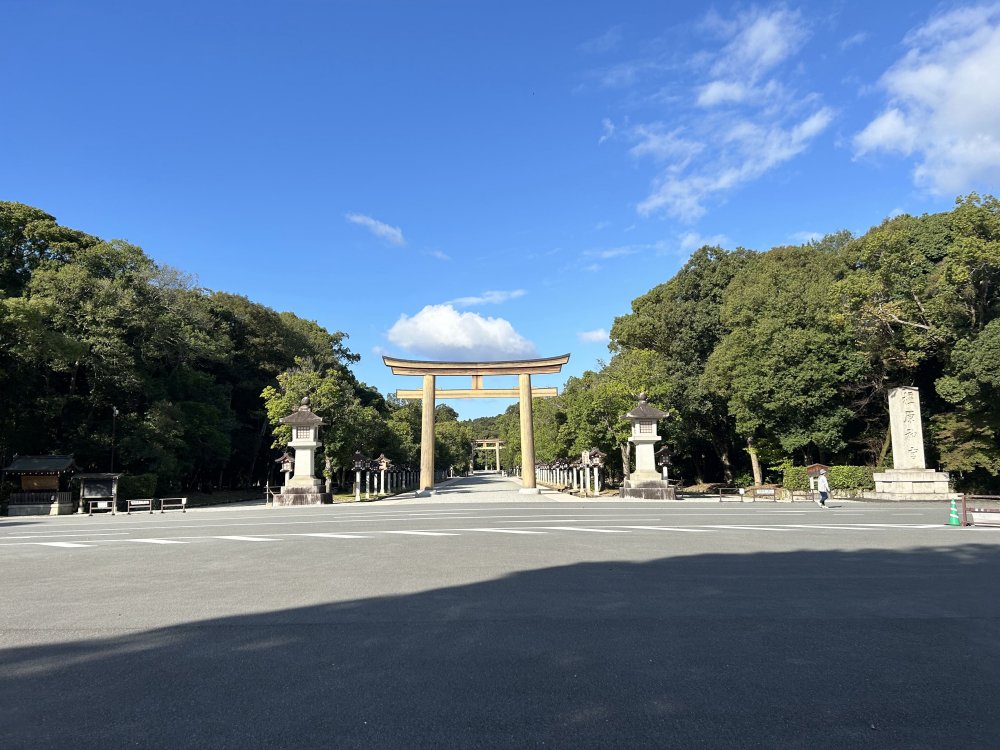
The grand first torii gate of Kashihara Jingu Shrine
I visited Nara again in early November 2024. This was my second visit this year, primarily to see the Shosoin Exhibition, held annually at this time, and to explore the places I missed during my previous visit in mid-year. The Shosoin Exhibition requires reservations, and I had a slot for 10:30 AM. I decided to visit the Shosoin itself first before the exhibition. The Shosoin is a building that houses treasures mainly belonging to the 45th Emperor Shomu (reigned from 724AD to 749AD). Many of the items were created in Japan and show influences from Western regions like Iran and India, brought over via the Silk Road. Some items are even directly from those regions. Notably, the treasures, originating from the imperial family, have been meticulously preserved due to strict management and the building's preservation-friendly construction.
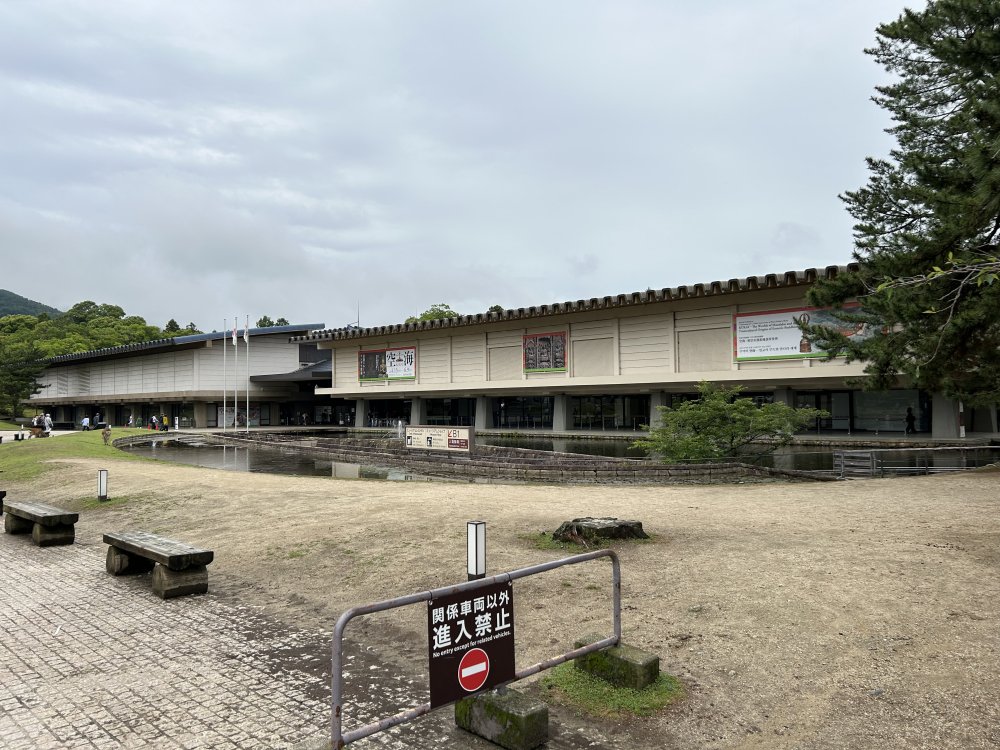
The Nara National Museum hosting the Shosoin Exhibition.
I knew Shosoin was located northwest of the Great Buddha Hall at Todai-ji,
but the actual walk was quite long. From the Nandaimon Gate, past the left
side of the Great Buddha Hall, and further north to Shosoin, it took about
15 minutes to cover the roughly 1-kilometer distance. When I finally arrived
at Shosoin, I discovered that it wouldn't open until 10 AM. Unfortunately,
that meant I wouldn't make it to my reservation for the Shosoin Exhibition.
So, I had to content myself with a view of Shosoin from the western side,
peering over the fence.
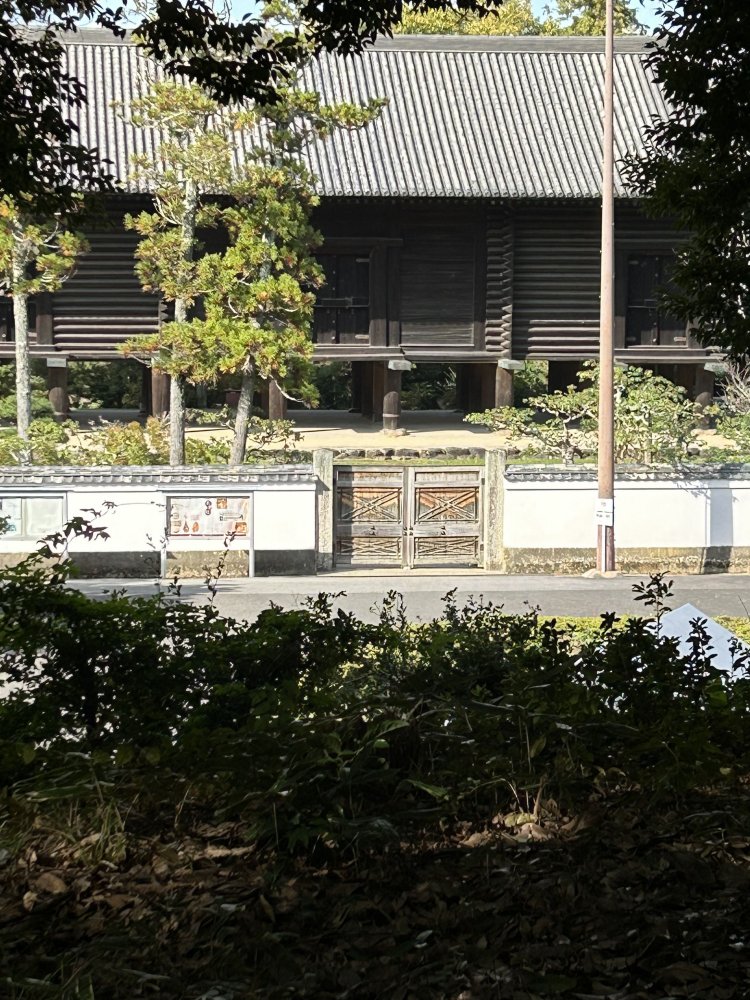
The Shosoin is a building that houses treasures mainly belonging to the 45th Emperor Shomu (reigned from 724AD to 749AD). I had to content myself with a view of Shosoin from the western side, peering over the fence.
When I arrived at the Nara National Museum for the Shosoin Exhibition, despite having a reservation, I had to wait outside in line until my time slot. The exhibits were impressive with detailed explanations, but it took some time to get close to the ones that interested me due to the crowds. By the time I finished exploring the first and second exhibition rooms, it was already past noon. The gift shop had long lines and the restaurant was full, but the Buddhist Statue Hall, connected by an underground passage, was relatively empty. The pair of A and Un Kongo Rikishi (Vajrapāni) statues (A is the first word of the Sanskrit alphabet pronounced with the mouth closed. Un is the last word pronounced with the mouth open. Similar to alpha and omega, A-Un is used to symbolize the beginning and end of the universe. It is common to have a pair of A and Un Kongo Rikishi statues placed at the entrance gate of major Buddhist temples as a protector against evil and intruders), displayed there during the restoration of Kinpusen-ji’s Niomon Gate, were particularly striking.
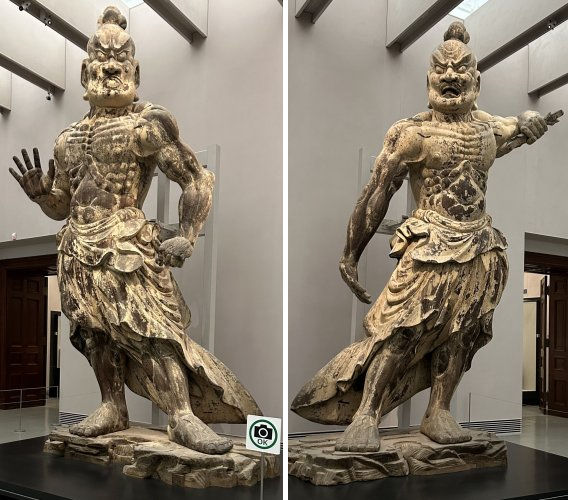
The A and Un Kongo Rikishi statues. A statue on the right and the Un statue on the left.
After leaving the Nara National Museum, I took a bus east to visit Saidaiji Temple via the Heijo Palace Site. Saidaiji is about a five-minute walk from Kintetsu Saidaiji Station. Geographically, it mirrors the location of Todai-ji Temple on the opposite side of Heijo-kyo. Just as Todai-ji was established by Emperor Shomu’s royal call, Saidaiji is said to have been founded by Empress Shotoku, daughter of Emperor Shomu, who commissioned bronze statues of the Four Heavenly Kings to be enshrined there. Originally a grand temple complex, it was completed in 780, ten years after Empress Shotoku’s death. Saidaiji has had a less fortunate history compared to Todai-ji. After the capital moved to Kyoto, it was neglected as old Buddhism and suffered numerous disasters, leading to its decline. Though it experienced a revival during the Kamakura period, many buildings were lost due to civil war in 1502. During the Edo period, it received land donations from the shogunate, resulting in its current form. The present temple grounds cover about 8 acres, roughly one-fifteenth of its original size.
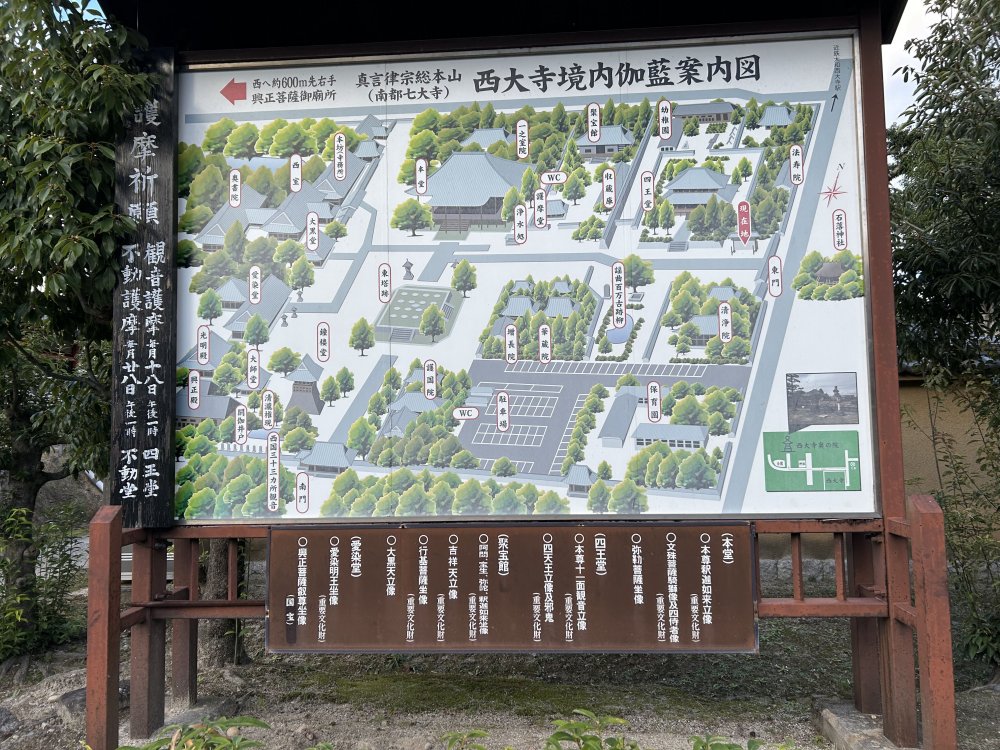
Map of Saidaiji Temple complex by the East Gate. The East Gate is by the red "You are here" sign on the right and the Shiodo Hall mentioned below is on the left of the red sign.
Entering the temple grounds through the East Gate, which is closest to Kintetsu Saidaiji Station, the first building you see on your right is Shioudo Hall. The entrance fee here is 800 yen. This hall, rebuilt in 1674 during the Edo period, enshrines the Four Heavenly Kings as per the wishes of Empress Shotoku. Upon removing your shoes and stepping into the hall, you'll find a towering 6-meter Eleven-faced Kannon statue in the center, with over 2-meter statues of the Four Heavenly Kings. Originally from a temple in Kyoto, the Eleven-faced Kannon statue was relocated here in the late 13th century as a kind of guest principal image. It is a wooden gilded statue from the late Heian period, created around 1145, and is designated as an Important Cultural Property. The Four Heavenly Kings behind the Kannon statue also designated as Important Cultural Properties are believed to be from the Muromachi period (14th to 16th century), with the statues of Jikokuten, Zochoten, and Komokuten made of bronze, and only Tamonten being made of wood. The imp trodden by the Heavenly Kings dates back to the 8th century. Walking around these statues in the not-so-spacious hall envelops you in a solemn atmosphere.
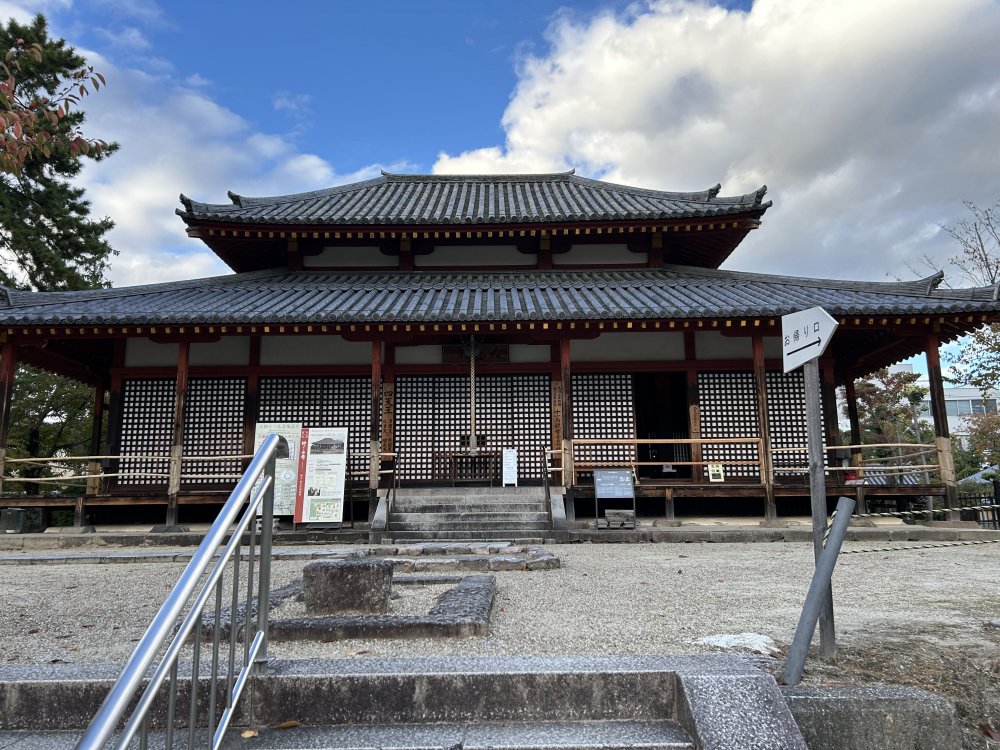
Shioudo Hall. The entrance fee here is 800 yen. This hall, rebuilt in 1674 during the Edo period, enshrines the Four Heavenly Kings as per the wish of Empress Shotoku.
Continuing past Shioudo Hall, I arrived at a spacious area. In the center of this square, there is a slightly elevated section which marks the site of the East Pagoda. This is where the foundation stones of the East Pagoda, one of the grand 45-meter tall five-storied pagodas of Saidaiji built in the 8th century, are located.
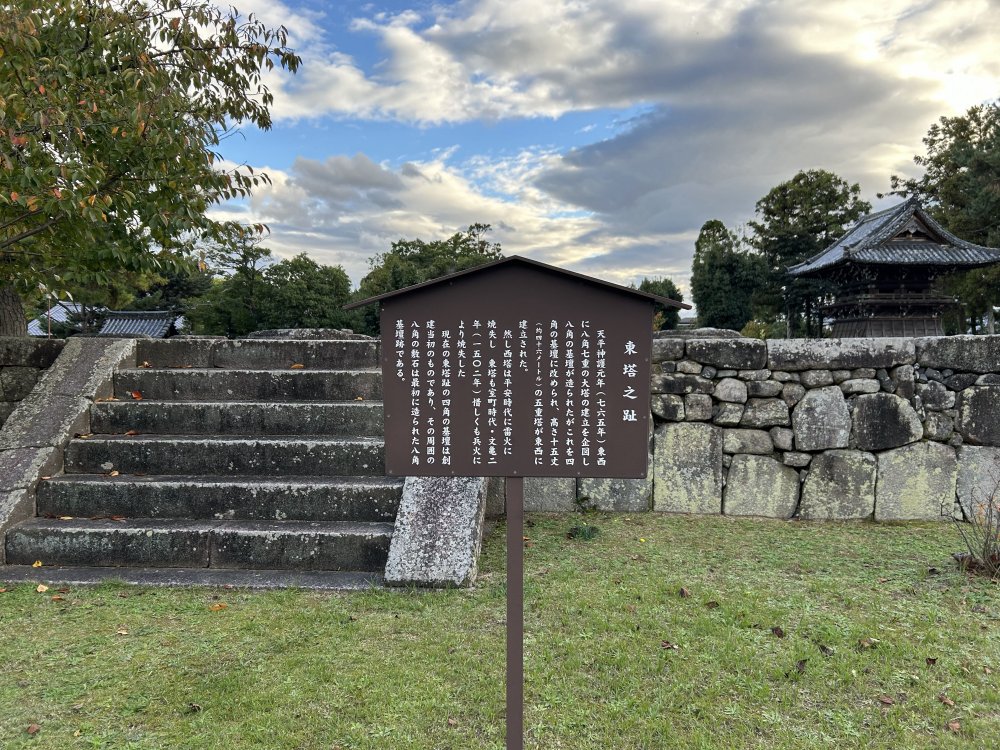
Elevated section which marks the site of the East Pagoda where the East Pagoda, one of the grand 45-meter tall five-storied pagodas of Saidaiji built in the 8th century once stood.
On the northern side of the square stands the Hondo (Main Hall). This wooden
structure, built in the late 18th century, features a unique architectural
style without the use of earthen walls. The principal image enshrined here
is a Shakamuni Buddha statue from the Kamakura period.
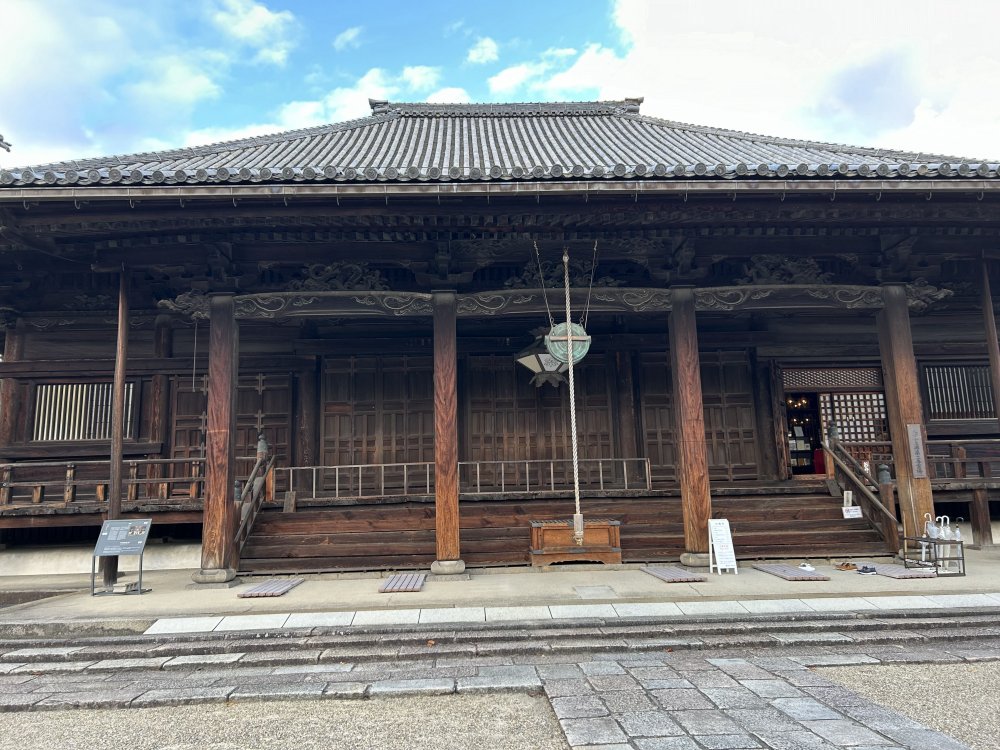
The Hondo (main hall) built in the late 18th century features a unique architectural style without the use of earthen walls.
Further ahead from the Hondo lies the Aizendo Hall. This structure was relocated from a Kyoto noble's residence in the 18th century. The main statue worshipped here is that of Aizen Myo-o (Rāgarāja; click here to see the statue on Saidaiji’s website). Although I had paid the entrance fee and could have visited, I decided to skip it this time as the sun was setting. I then took a Kintetsu train from Kintetsu Saidaiji Station, got off at Kashiharajingu Station, and stayed overnight in Kashihara City.
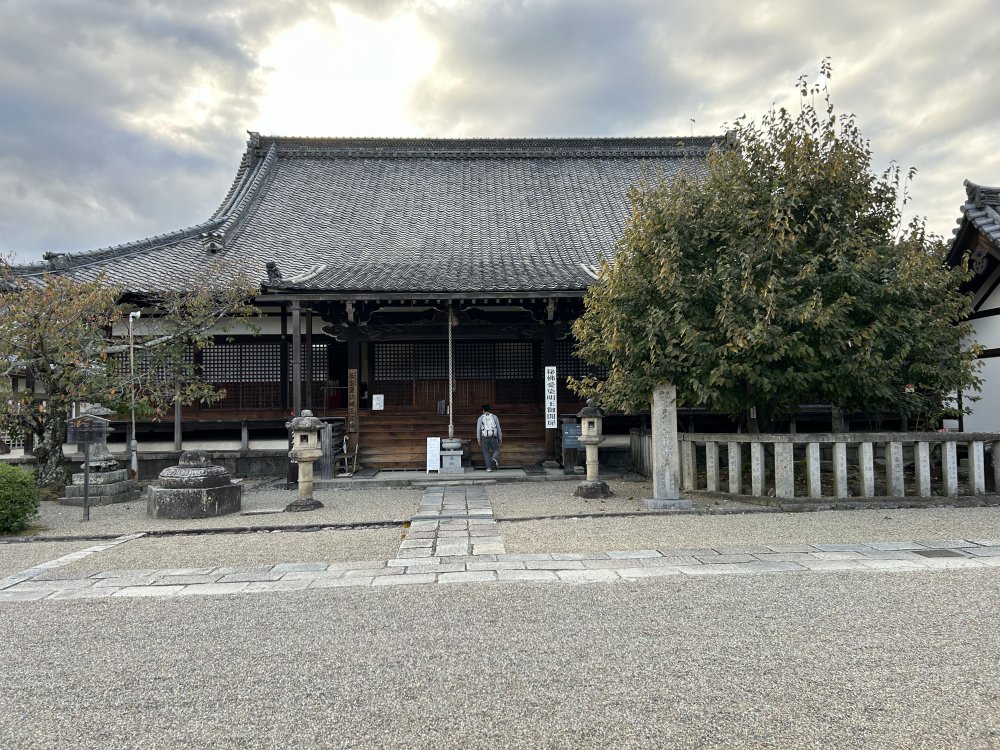 /p>
/p>
The Aizendo Hall relocated from a Kyoto noble's residence in the 18th century houses a statue of Aizen Myo-o.
Kashihara Shrine is the legendary site where Emperor Jimmu, the first Emperor
of Japan, is said to have unified Yamato and ascended to the throne, according
to the oldest historical and mythological texts compiled in the early 8th
century, the Kojiki and Nihon Shoki. The shrine itself was founded in 1890
during the Meiji period, with the overall design by Chuta Ito. It is located
at the southern foothills of Mt. Unebi, which stands about 200 meters tall
and has been cherished since ancient times. From Kintetsu Kashiharajingu
Station, it’s about a five-minute walk northeast to the shrine's first
torii gate.
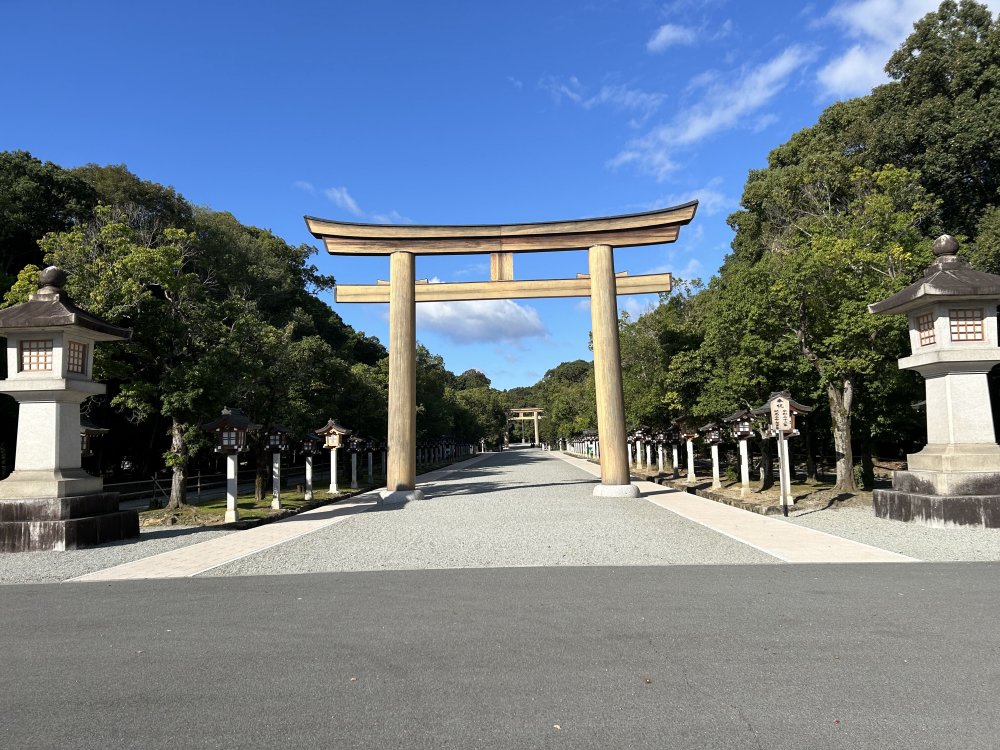
The former Nara Prefecture Product Exhibition Hall built in 1898 was designed to harmonize with the landscape of Nara Park.
From the first torii gate, I followed the path east, passing through the
second torii gate. After a short walk, I came upon the South God’s Gate
(Minami Shinmon) on my right. Passing through this magnificent gate, I
entered the vast plaza in front of the main hall.
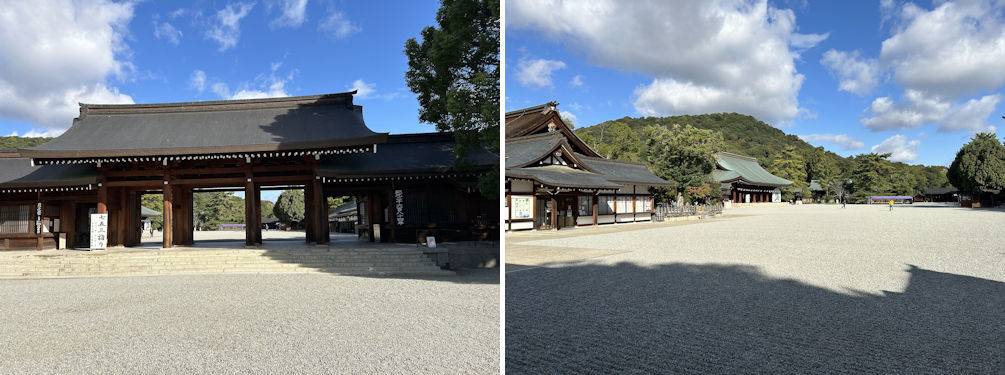
The grand South God's Gate (left) leading to the vast shrine plaza (right) The honden (main shrine building) can be seen in the middle.
I first paid a visit to the Honden (main shrine building) from the Gehaiden
(outer worship hall). The Honden is not open to the public and can only
be viewed from the Gehaiden. It was originally the Naishidokoro of the
Kyoto Imperial Palace (the building housing the sacred mirror, Yata no
Kagami, one of the Three Sacred Treasures symbolizing the authority of
the Emperor) and was relocated here in 1889. This building is designated
as an Important Cultural Property.
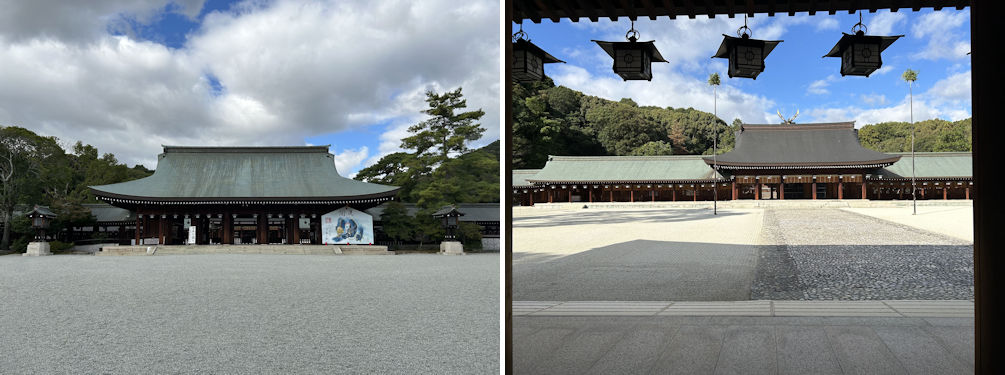
The Gehaiden (left) and the Honden viewed from the Gehaiden (right)
Since it was the time for Shichigosan (to learn more about the Shichigosan
ritual please click here), a Go board was placed at the end of the Gehaiden’s corridor for children
to perform the "Go Board Vow." Children stand on the Go board
and jump forward with the wish for health in both body and mind.
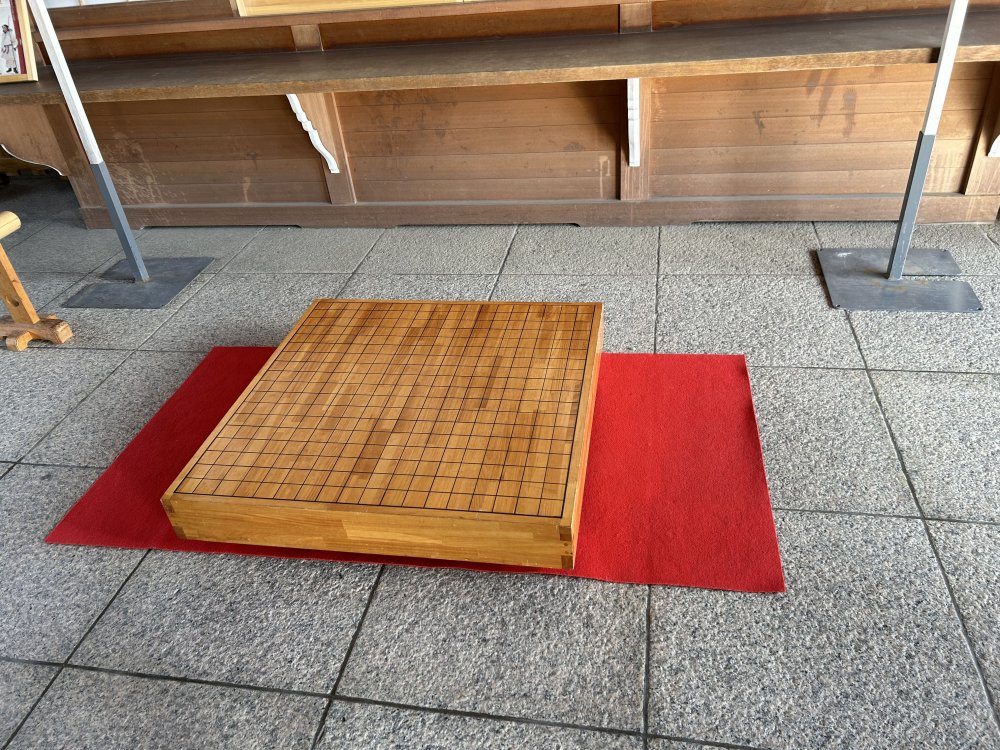
Since it was the time for Shichigosan, a Go board was placed at the end of the outer hall’s corridor for children to perform the "Go Board Vow.
Customary to the season, a chrysanthemum exhibition was also being held
here.
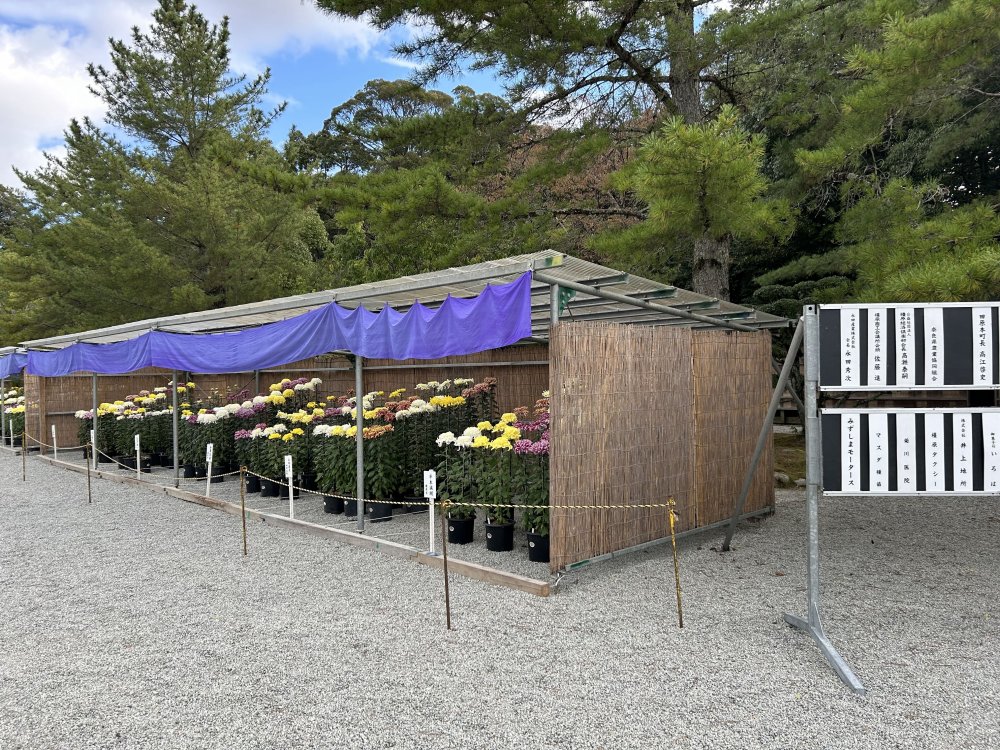
The chrysanthemum exhibition amd list of exhibitors on the right.
To the left of the Gehaiden is the Sarugakuden. Originally, it was the
Shinkaden (the hall where the Emperor conducts rituals serving the Gods)
of the Kyoto Imperial Palace, built in 1855, gifted to Kashihara Shrine
along with the main hall upon its founding in 1890. However, after it was
destroyed by fire in 1993, the current building was reconstructed in 1996.
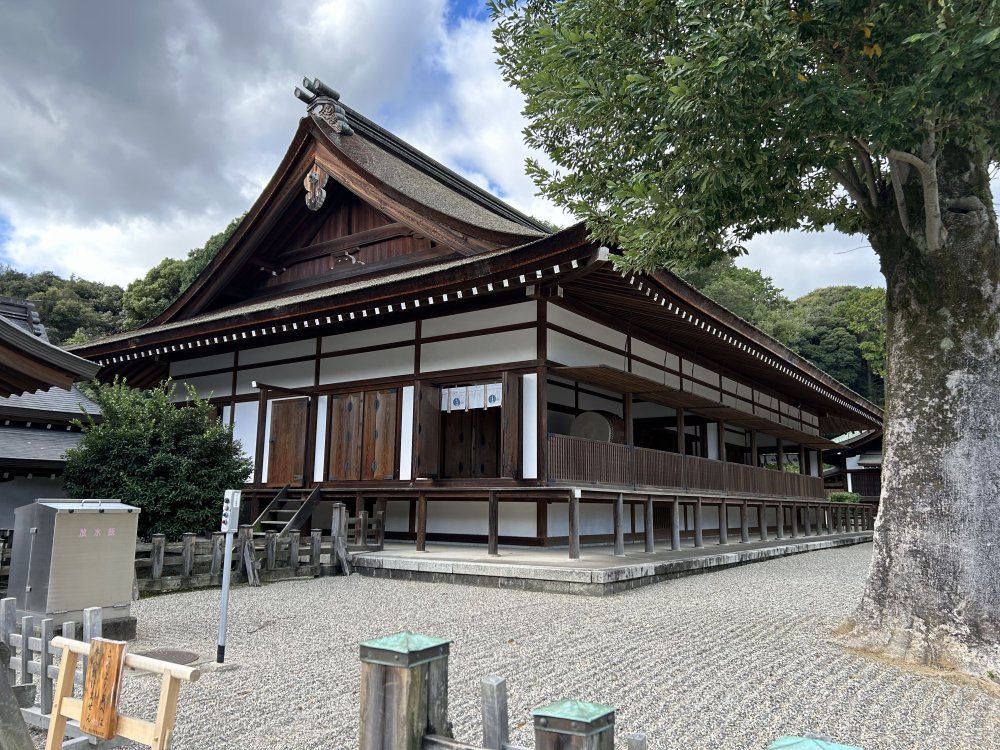
The Sarugakuden originally was the Shinkaden of the Kyoto Imperial Palace, built in 1855, until it was gifted to Kashihara Shrine along with the Honden in 1890.
Passing through the South God’s Gate again and continuing past the Temizuya
(a place where visitors cleanse their hands and mouths before praying),
I arrived at a large pond called Fukasawa Pond. This pond is said to have
been created during the Asuka period (7th century).
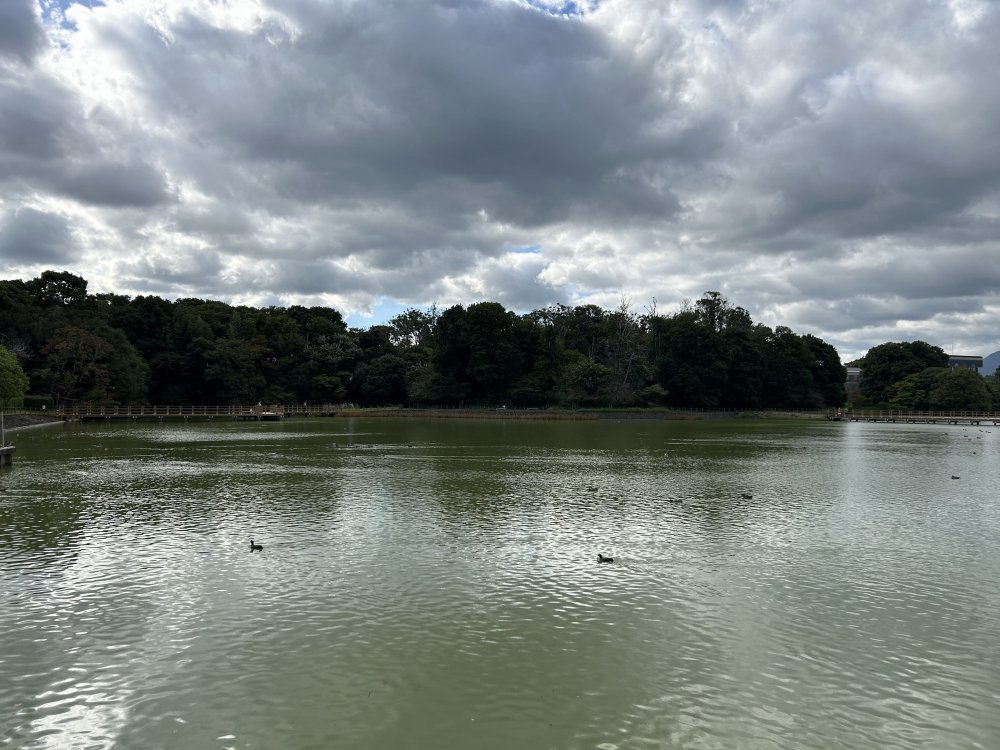
The Fukasawa Pond is said to have been created during the Asuka period (7th century).